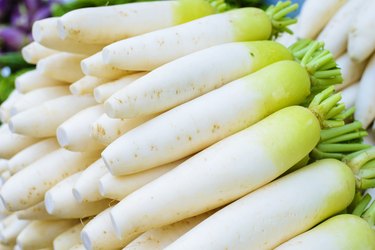
Daikon radish is known by a variety of other names, including lo bak, white radish, Chinese radish, Oriental radish and icicle radish. A Chinese turnip is more commonly known as a jicama. For both vegetables, the large, white root is the portion that is most commonly used, although the leafy greens can also be sauteed or eaten raw. Both daikon and Chinese turnip are a crisp textured vegetable that is low in fat, and contains a number of essential nutrients.
Identifying Daikon and Chinese Turnip
Video of the Day
Daikon is most commonly harvested as the larger, more mature version of the icicle radish, which, when harvested small, looks like a white baby carrot. Daikon has a milder taste than the traditional red radish and is often used as a garnish or primary ingredient in Asian cooking. Chinese turnip is globular and tan colored, although the inner flesh is white and crisp texutred, like daikon. The flavor of the Chinese turnip is milder than daikon, closer to a water chestnut, although not as sweet, than a radish. Both daikon and Chinese turnip can be eaten raw or cooked.
Video of the Day
Daikon Nutritional Profile
A single, 7-inch long daikon has 61 calories per serving, a little over 2 grams of protein and less than half a gram of fat. As a crisp vegetable, a single daikon has almost 320 grams of water. While the serving size may seem large, daikon is commonly eaten as a primary ingredient in vegetable dishes in Asian cuisine, so a single daikon is not considered too large. Daikon is also rich in potassium, and is a source of calcium and magnesium. It is also rich in vitamin C and folate, as well as being a good source of other B vitamins.
Chinese Turnip Nutritional Profile
Half of a raw, medium Chinese turnip, weighing roughly the same as the daikon, has 139 calories per serving, 2.6 grams of protein and less than half a gram of total fat. As it is also a crisp vegetable, it has almost 300 grams of water per serving. Like the daikon, the Chinese turnip is often eaten as the primary vegetable in Asian dishes, where a whole platter of sauteed slices is not uncommon, so the large serving size is common. Chinese turnips are rich in potassium and are a source of calcium and phosphorus. They are also rich in folate, vitamin E and vitamin K, as well as containing vitamin C and members of the B vitamin group.
Dietary Fiber Content
Chinese turnip has more dietary fiber than daikon per serving, although both are good sources of fiber. A single daikon contains 5.4 grams of dietary fiber, which provides 14 to 22 percent of the recommended dietary intake of fiber per day. A serving of raw jicama has 16.1 grams of dietary fiber, which provides 42 to 64 percent of the recommended dietary fiber intake. Most Americans do not include enough fiber in their diet, eating less than the 25 to 38 grams that is recommended. Dietary fiber reduces the symptoms of constipation and other digestive disorders, including irritable bowel syndrome as well as diverticulosis. Fiber also reduces your risk of heart disease, and is known to lower cholesterol levels.
Ways of Eating
Both daikon and chinese turnip can be eaten cooked or raw. Daikon, sliced thinly, is commonly used as a garnish for sushi dishes, as well as being a crunchy, refreshing addition to salads. Slices or sticks of both Chinese turnip or daikon can be made into fresh pickles. Chinese turnip is often shredded and added to spring rolls in South East Asian cooking. Daikon and Chinese turnip can be quickly stir-fried, which preserves its crunchy texture, while adding crunch and juiciness to a dish. A traditional Chinese dish called lo bak gow, or turnip cake, uses shredded, cooked daikon or Chinese turnip to produce a sticky, filling cake that is pan fried. For an easier to prepare method, roast the daikon or Chinese turnip whole or cut up into pieces, the same way you would with potatoes, seasoning with fresh herbs and sea salt.
- The Cook's Thesaurus: Radish
- U.S. Department of Agriculture: Radishes, Oriental, Raw
- Colorado State University: Dietary Fiber
- Fruits and Veggies More Matters: Top 10 Ways To Enjoy Daikon Radish
- TasteHongKong.com: Turnip or Radish Cake With Chinese Sausage
- U.S. Department of Agriculture: Yambean (jicama), Raw